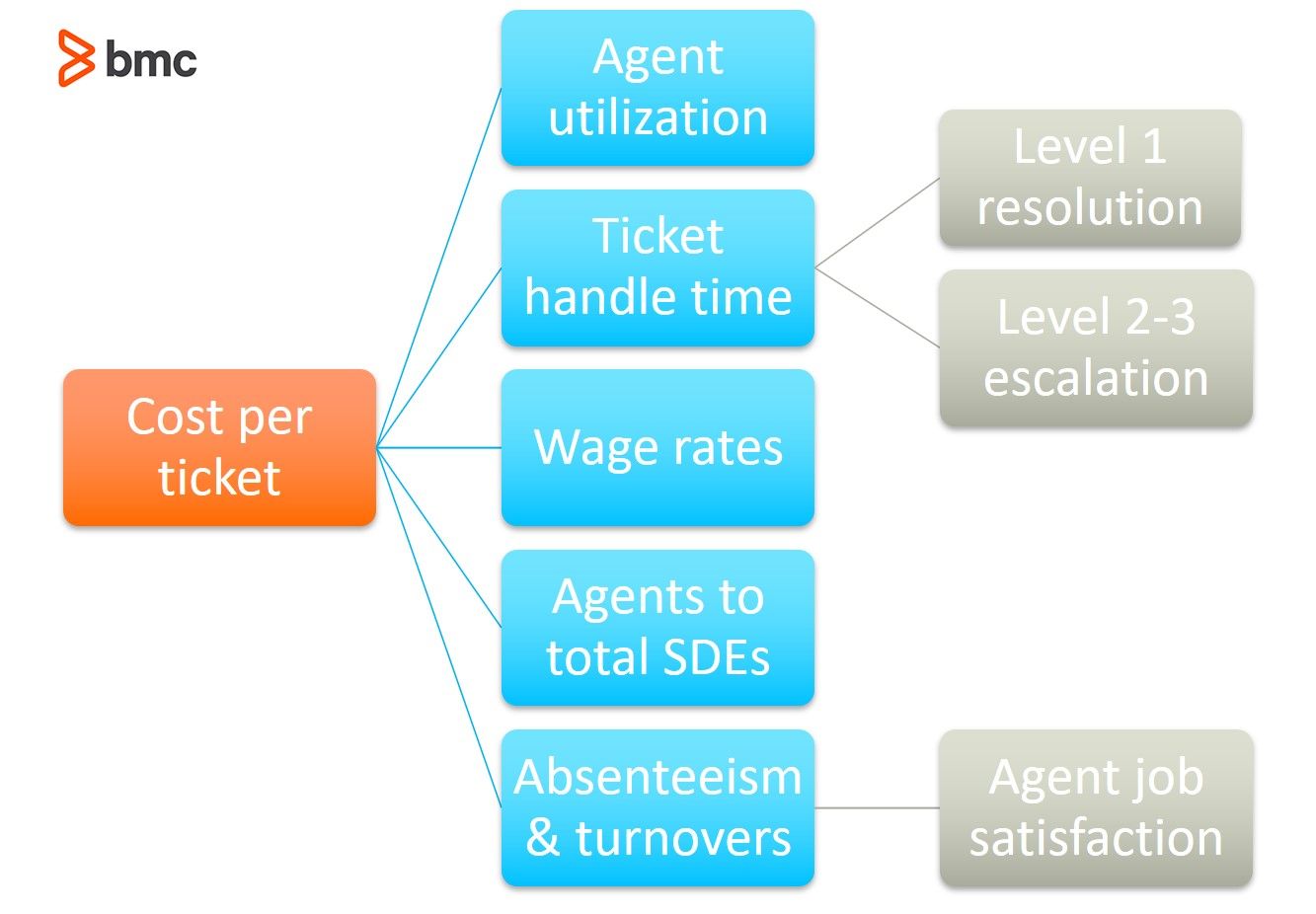When it comes to IT service management, we’ve all had our share of metrics: length of calls, time to resolution, customer satisfaction, etc. Whether you’re looking to streamline your IT service desk metrics or you’re just getting started implementing them, there is one service desk metric to rule them all—cost per ticket.
Unfortunately, a lot of service desks do not know their cost per ticket. Cost per unit is a common metric in every economy–we all know the cost for a gallon of gas, a movie ticket, or an ice cream cone. So, why don’t all IT service and support managers know their service desk cost per ticket? Let’s explore this metric and how the successful understanding of it can mean both increased service desk efficiency and higher customer satisfaction.
What is the cost per ticket?
Cost per ticket is a straightforward calculation. It is the total monthly operating expense of your service desk divided by the number of tickets you had in that month. You may be asking yourself, if cost per ticket is a simple average cost calculation, why is it such an important service desk metric?
In customer service—the purpose of any service desk—there are two fundamental metrics: customer satisfaction, of course, and cost per ticket. While customer satisfaction can be quite subjective, cost per ticket is black-and-white objective. (All other metrics tend to boil down to another form of cost containment relative to service quality.)
Calculating the cost per ticket can illustrate a number of situations:
- You have high customer satisfaction, but you cost per ticket is higher than expected. You may determine that you’re OK with that cost or that you want to increase efficiency to lower that average cost.
- You are spending a lot of money per ticket, but the resulting customer satisfaction is terrible. You’ll want to examine why so much money is being spent (which we’ll get to later in this article).
- You have above-average customer satisfaction, but your cost per ticket is right on the regional average—that could be a huge advantage.
Looking at both cost per ticket and customer satisfaction shows the delicate, necessary balance between the two.
Determining the operating expense of your service desk
Calculating the cost per ticket might seem easy until you try to do so. For many companies, determining the monthly operating expense of your service desk can be complicated, perhaps because you haven’t tracked this information clearly in the past.
To determine your service desk’s operating expenses, you’ll want to include the following data:
- Salaries and benefits for service desk agents and indirect personnel, such as team leads, supervisors, managers, trainers, QA/QC personnel, workforce schedulers, dispatchers, and even interns or security personnel
- Technology and telecommunications expenses, such as computers, software licensing fees, ACD and VRU costs, and telecom equipment like headsets
- Facilities expenses, including office space, utilities, and insurance
- Travel
- Training
- Office supplies
Because IT support is so labor-intensive—you need enough staff to field the service requests—you’ll likely see a significant majority of your costs going to service desk personnel. Your company could easily see 60-70 percent of costs going to direct and indirect service desk employees.
The average service desk cost per ticket
For an efficient service desk team that provides satisfactory or above service, a majority of your service desk tickets should meet two rules of thumb: taking 10 minutes or less for a service desk employee to handle and costing $20 or less.
While the output of service desks varies widely, here are a few average numbers:
- Across North America in 2016, the average ticket cost was $15.56, with a low of $2.93 and a high of $46.69.
- Similarly, the cost per minute of service desk handle time averaged $1.60, with a minimum of 76¢ and a max of $2.50.
- In 2018, the cost per minute of service desk voice time was $2.13 on average.
What drives service desk cost per ticket?
A number of drivers can affect your service desk cost per ticket.
- Agent utilization. The more service desk agents (customer-facing employees) that are in use increases overall productivity. Generally, the cost per ticket decreases significantly as agent utilization increases beyond 60 percent.
- Ticket handle time. The faster an agent can satisfactorily handle a ticket, the more tickets the agent can take on. Of course, some tickets will escalate beyond Service Level 1. As a ticket reaches Levels 2 or 3, you can expect higher costs.
- Wage rates. These vary widely depending on your geography and regional cost of living. A ticket that takes 10 minutes to solve in the U.S. may cost $25 while the same ticket handled overseas only costs $10.
- Ratio of agents to total service desk employees. Every service desk should have a significant majority of customer-facing employees compared to support or management staff. A good average is 78 percent: if you have fewer service desk agents and more than 22 percent non-customer facing staff, you’re likely spending too much on personnel who don’t directly affect customer satisfaction.
- Turnover and absenteeism. The more short-staffed your service desk, the more overtime you must pay, which increases operating cost. If service desk turnover is high, you are paying a lot more per person to train and re-staff the desk. Investments in job training, coaching, and upward mobility go far to promote agent job satisfaction, which decreases turnover and absenteeism.

As service desks implement more self-service and chatbot tools for common issues, your cost per ticket will change accordingly. For instance, if most customers or employees are using self-service or chatbot options to handle low-level tickets, your service desk will see far fewer tickets—but these will likely be more sophisticated, requiring longer time and additional touch points.
When it comes to IT service management, utilize best-in-class solutions that clarify your cost per ticket and provide actionable changes based on real-time and historic service desk data.







